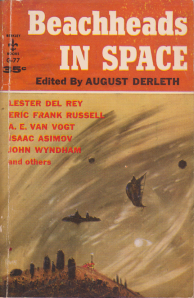The Book: Against the Fall of Night by Arthur C. Clarke. Originally published in the magazine Startling Stories in 1948, the edition read was published in 1954 by Perma Star, a division of Doubleday.

The Setting: Earth, in a distant future.
The Story: A boy defies his unquestioning, immortal society by traveling outside the bounds of the last city on earth, discovering another city with living people in it, making a friend, and traveling across the stars where he finds the key to rediscover history.
The Science: The book is set at least a billion years in the future. It’s a time so distant that making any assumptions about it are wholly useless because the variables are so many. But humans remain humans. Clarke makes the beautiful gesture of referencing intervening stages of evolutionary change, which I appreciated immensely. One group of humans is mostly normal, but pretty much immortal – lifespans of at least a million years. The other group of humans is also mostly normal – a more standard lifespan, but they have telepathy. The story reveals, near its end, that it was scientific manipulation of the genome which led to these developments in the first place, but long periods of evolutionary divergence which led to the disparate groups. Not quite species, because interbreeding seems possible, but very disparate.
It’s all the more striking when you compare the timeline of the book, a billion years in the future, with how long it took to go from anatomically modern humans to Homo sapiens. 200,000 years. That’s a blink of the eye to distant future of this story.
The Reaction: This is a story, first and foremost, about what makes us human. There are many parallels with Destination Infinity – a distant future, an isolated and waning civilization, individuals with something so close to immortality it hardly matters whether it is or not, and a character which defies the status quo. But this story has a very likable protagonist – he’s a kid. In fact, I bet this is shelved under Young Adult in many libraries because of that very fact.
I liked this book a great deal. There are a lot of little bits of plot which seem kind of pointless or are unexplored, but this is a good story, and worth reading.
The Cover: Young man running from a desert toward a rocket and stars? Yep, that’s the story right there, with great art and some really excellent 1950s hair.
Next Up: “Fever Dream” by Ray Bradbury








